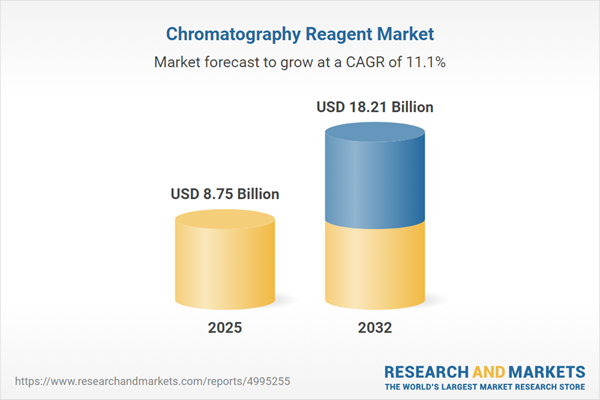Speak directly to the analyst to clarify any post sales queries you may have.
The chromatography reagent market is experiencing rapid transformation, shaped by technological advancements, regulatory change, and increasing expectations around quality and sustainability. Senior decision-makers are seeking actionable insights to navigate supply chain complexities and maximize value in an evolving global environment.
Market Snapshot: Chromatography Reagent Market Growth and Outlook
The chromatography reagent market grew from USD 7.86 billion in 2024 to USD 8.75 billion in 2025, with ongoing expansion projected at a CAGR of 11.06%. By 2032, the market is forecasted to reach USD 18.21 billion. This upward trend is driven by increasing demand across research, clinical, and industrial settings. Regulatory pressures, the need for high-performance analytical solutions, and expanding application areas continue to accelerate growth across key regions and industry segments.
Scope & Segmentation of the Chromatography Reagent Market
This report provides a detailed evaluation of the chromatography reagent landscape, enabling informed strategic decisions.
- Product Type: GC reagents (calibration standards, carrier gases, stationary phases), HPLC reagents (buffers such as acetate, formate, and phosphate, mobile phase additives, solvents like acetonitrile and methanol), and ion chromatography reagents (eluents, standards, suppressors).
- End Use Industry: Academic research, biotechnology and biopharmaceuticals, environmental testing, food and beverage, pharmaceuticals.
- Technology: Gas chromatography (GC, GC-MS), liquid chromatography (HPLC, UPLC), ion chromatography (ion exchange, ion exclusion), and thin layer chromatography (analytical and preparative).
- Application: Biochemical research, clinical diagnostics, drug analysis, environmental monitoring, food safety testing, forensic analysis, petrochemical analysis.
- Region: Americas (United States, Canada, Mexico, Brazil, Argentina, Chile, Colombia, Peru), Europe, Middle East & Africa (United Kingdom, Germany, France, Russia, Italy, Spain, Netherlands, Sweden, Poland, Switzerland, UAE, Saudi Arabia, Qatar, Turkey, Israel, South Africa, Nigeria, Egypt, Kenya), Asia-Pacific (China, India, Japan, Australia, South Korea, Indonesia, Thailand, Malaysia, Singapore, Taiwan).
- Leading Companies: Thermo Fisher Scientific Inc., Merck KGaA, Agilent Technologies Inc., Waters Corporation, Shimadzu Corporation, Danaher Corporation, PerkinElmer Inc., Bio-Rad Laboratories Inc., Avantor Inc., TOSOH Corporation.
Key Takeaways for Strategic Decision-Makers
- Technological innovation is enhancing separation precision and reproducibility, supporting complex analytical and preparative workflows across industries.
- Increasing automation and AI-enabled instrumentation are raising requirements for reagent stability, compatibility, and digital integration to meet evolving laboratory needs.
- Stringent regulatory frameworks and advanced safety standards are driving the development of high-purity and application-specific reagent solutions.
- Global demand is fueled by growth in drug discovery, environmental testing, food safety, and clinical diagnostics—diversifying both product requirements and supply chain needs.
- Sustainability imperatives are prompting the adoption of green solvents, recyclable materials, and waste-minimization practices in reagent manufacturing and usage.
- Collaborative industry partnerships, including digital supply chain services and subscription models, are improving operational continuity and customer retention.
Tariff Impact: Navigating Supply Chain and Cost Considerations
The 2025 United States tariff adjustments are prompting industry stakeholders to reassess procurement strategies and diversify supplier relationships. Tariffs applied to key reagents and chemical precursors add new complexity to contract negotiations and inventory management. In response, organizations are adopting strategies ranging from nearshoring to strategic inventory planning and leveraging regional consortiums. Regulatory and trade bodies are working toward standardized reagent classifications, promoting smoother customs processes. The emphasis on procurement agility and scenario planning is strengthening resilience across value chains and budgeting frameworks.
Methodology & Data Sources
This analysis is based on a rigorous, multi-phase research methodology, combining primary interviews and workshops with laboratory, procurement, and regulatory experts. Secondary data from peer-reviewed literature, patent filings, industry reports, and official regulatory sources was triangulated to ensure accuracy and relevance.
Why This Report Matters
- Enables clear benchmarking of technological advances, regulatory influences, and supply dynamics across every major chromatography reagent segment.
- Empowers executives with actionable insight for procurement, risk management, and innovation investments in a rapidly evolving landscape.
- Supports strategic planning by mapping out regional trends, partnership opportunities, and evolving sustainability requirements.
Conclusion
This report equips senior leaders to anticipate and address emerging risks and opportunities within the chromatography reagent market. Applying these insights supports strategic differentiation, operational resilience, and sustainable growth in a complex, competitive environment.
Additional Product Information:
- Purchase of this report includes 1 year online access with quarterly updates.
- This report can be updated on request. Please contact our Customer Experience team using the Ask a Question widget on our website.
Table of Contents
3. Executive Summary
4. Market Overview
7. Cumulative Impact of Artificial Intelligence 2025
Companies Mentioned
The companies profiled in this Chromatography Reagent market report include:- Thermo Fisher Scientific Inc.
- Merck KGaA
- Agilent Technologies, Inc.
- Waters Corporation
- Shimadzu Corporation
- Danaher Corporation
- PerkinElmer, Inc.
- Bio-Rad Laboratories, Inc.
- Avantor, Inc.
- TOSOH Corporation
Table Information
| Report Attribute | Details |
|---|---|
| No. of Pages | 185 |
| Published | October 2025 |
| Forecast Period | 2025 - 2032 |
| Estimated Market Value ( USD | $ 8.75 Billion |
| Forecasted Market Value ( USD | $ 18.21 Billion |
| Compound Annual Growth Rate | 11.0% |
| Regions Covered | Global |
| No. of Companies Mentioned | 11 |









